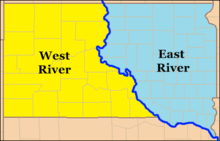West River (South Dakota)

West River is the portion of the state of South Dakota located west of the Missouri River with well over one-half of the land area and between one-quarter and one-third of the population of the state.
The contrast between the two regions is striking. While East River is predominantly a corn- and wheat-growing region, with large numbers of pigs and poultry operations, West River is predominantly ranching with some dryland farming. Population has decreased as family farms declined due to the harsh conditions and industrialization of agriculture. Other than aggregates, all mining in South Dakota (including gold and other precious metals, industrial minerals, iron ore, and coal) is located in West River, which includes the Black Hills. Both areas were occupied for thousands of years by varying cultures of indigenous peoples. The historical Great Plains tribes, especially the Lakota or Sioux groups, held most of the territory west of the river.
While European-American settlement of East River was largely by homesteaders moving west from Iowa and Minnesota, or immigrants arriving by train from eastern US seaports, West River was settled first by gold-seekers and miners; many from older gold rush locations to the west, such as Montana and Colorado, followed by ranchers from Texas, Kansas, and Colorado. As a result, while East River has a high Scandinavian and German-descended population and a culture similar that of Minnesota, West River has a more general European-American population and a culture similar to the Mountain states.
Nearly 9% of South Dakota's population is Native American[1] and Indian Reservations are located in both sides of the state. More than 20% of the population of West River is of Native American descent; this includes primarily Lakota residents of the five West River reservations (once united as the Great Sioux Reservation), as well as populations in urban centers such as Rapid City. In the 1990s, Bennett County's population became majority Native American. In the 2002 elections, Oglala Lakota candidates won positions as county sheriff, one of the county commissioners, and a seat on the county school board.[2]
West River has a larger military influence on the economy, with both Ellsworth Air Force Base and most installations of the South Dakota Army National Guard there; only the South Dakota Air National Guard is located in East River (at Joe Foss Field in Sioux Falls). West River is politically more conservative and Republican than East River,[3] but the state Republican Party is normally dominated by East River interests. Walter Dale Miller, the only West River governor in the state's recent history, came to office in 1993 due to the death of Governor George S. Mickelson.[4] Given the military installations, subsidies for farming and ranching, and Indian reservations, West River residents share a "mutual economic dependency upon the federal government."[2]
References
- ↑ South Dakota QuickFacts from the US Census Bureau
- 1 2 Sterling Fluharty. "Review of Wagoner, Paula L., "They Treated Us Just Like Indians": The Worlds of Bennett County, South Dakota ", H-AmIndian, H-Net Reviews, March 2004, accessed 8 June 2011
- ↑ Johnson, Dirk. "Gold Divides Dakotans as River Did", The New York Times, 9 October 1988. (accessed 14 February, 2008)
- ↑ The Political Graveyard: Index to Politicians: Micheau to Middleswarth
Coordinates: 44°30′N 102°00′W / 44.5°N 102°W